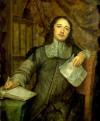Bibliography
When the publisher Jan Meyssen asked Cornelis de Bie to write a book on painters, he started out to write the most important Dutch book on painters of the seventeenth century. This book of artist biographies continues the traditions of Karel van Mander's Schilder-Boeck and Giorgio Vasari's Vite. He used biographical material from Karel van Mander and Giorgio Vasari, but the importance of this work is that it is the only known biography for many painters of the seventeenth century that were active after Vasari and van Mander's periods. Because it is written in verse form, it is rather difficult to read today, but it is longer than 500 pages and includes engravings of more than 50 painters from period paintings and drawings. He was an important source for Arnold Houbraken, who refers to him as K. de Bie, short for Kornelis de Bie.
The work was first published in 1662 in Antwerp and De Bie has prepared a second edition of the work, but that was never published and the manuscript is now in the Koninklijk Bibliotheek van België (Royal Library of Belgium) in Brussels. The work included the biographies of painters, sculptors and architects, both already deceased and living. Most of the work is written in verse and therefore, it is rather a panegyric. The full title of the work is Het Gulden Cabinet vande edele vry Schilder-Const, Ontsloten door den lanck ghewenschten Vrede tusschen de twee machtighe Croonen van Spaignien en Vrancryck, Waer-inne begrepen is den ontsterffelijcken loff vande vermaerste Constminnende Geesten ende Schilders Van deze Eeuw, hier inne meest naer het leven af-gebeldt, verciert met veel vermakelijcke Rijmen ende Spreucken. There are also indications that it was rapidly set and printed and therefore, it is possible that it was mainly meant as a commercial work.






